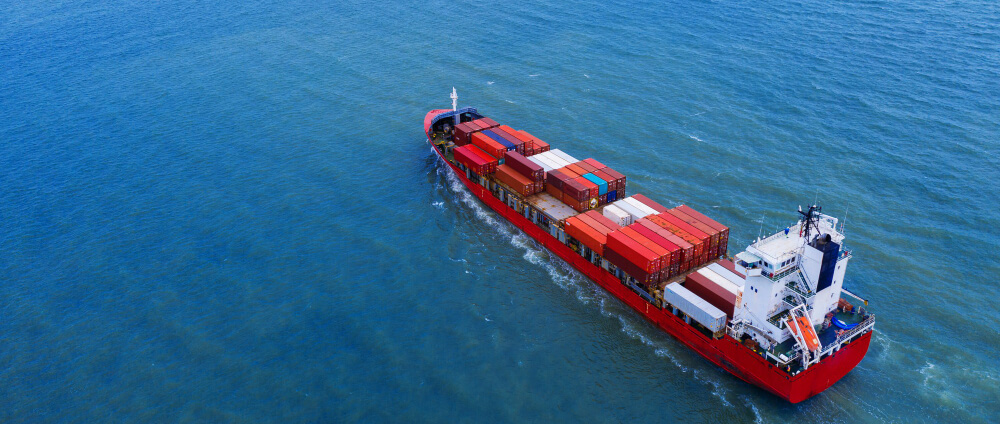We have several types of sea cargo that we are going to talk about in this article, stay tuned until the end of the article.
What are the types of sea cargo?
1.Container ships
It is the most widely used mode of sea freight transportation. These vessels, as the name implies, are intended to transport standard 20′, 40′, and 45′ containers. They can accommodate the majority of dry-load transport. Their capacity ranges from 85 to 15,000 TEUs (twenty equivalent units). The Emma Maersk is the largest container ship. The boxes are loaded and unloaded using gantry cranes.
2.General cargo ships
They primarily transport packaged goods and do not have space for containers. Once at the port, they use their own built-in cranes for loading and unloading operations.
3.Tankers
They are intended for the bulk transport of liquid cargoes such as petroleum products (oil, gas), chemicals, wine, juice, and so on. They are further classified based on the type of cargo carried.
4.Dry bulk carriers
They are designed specifically to transport bulk quantities of solid non-packaged loose dry cargo. These carriers are then used for bagged cargo (cement, wheat, sugar…), palletized cargo (paints, chemicals…), minerals (coal, iron ore…), food grains, timber…, and other similar products. They are outfitted with spoon-shaped cranes for loading and unloading, and their decks have designated areas for this purpose.
5.Multi-purpose vessels
Because of separate containers and storage systems, they can transport a variety of goods (general cargo, liquid). They are primarily used on routes that require self-geared ships and lack shore-handling facilities.
6.Reefer ships
They are intended for the transportation of frozen/temperature-controlled cargo, primarily in refrigerated containers. Food and perishable goods (fruits, vegetables, meat, fish…) are transported on such vessels and are kept at a very low temperature to ensure their safety during the voyage.
7.Roll-on/roll-off vessels
Ro-Ro is an abbreviation for roll-on/roll-off. These ships use ramps and platforms to transport wheeled cargo ranging from private cars to industrial vehicles or lorries such as buses, trucks, construction equipment, excavators, and so on. Depending on whether the vehicles are self-propelled or not, they can roll directly on and off the vessel, whether driven or by wheeled handling equipment with wheels.
Ro-Ro vessels are further classified as follows:
Pure Car Carrier (PCC) is only for cars; Pure Car and Truck Carrier (PCTC) is for both cars and trucks.
Ro-Ro ships can also transport other types of cargo as well as passengers.
Ships that transport containers and wheeled cargoes are referred to as “ConRo ships” (Ro-Lo); ships that transport general cargo and vehicles are referred to as “GenRo ships.”
RoPax ships are ships that transport passengers as well as cars and other vehicles (ferries).
Advantages of sea cargo
1.Transporting large items
Goods with a large volume and a heavyweight can be transported as easily as possible using the sea transportation system. There will be no damage to the goods if you use sea transportation to move large and heavy items. All of these benefits are contingent on you paying a very small fee to move these goods in this case. It is one of the most significant advantages of sea transportation.
2.Transportation of goods in any condition
It is possible that a country is extremely reliant on the sea transportation system and must therefore use it to transport its goods in any situation. Yes, the sea transportation system is applicable in all circumstances. Heavy rains, snowfalls, floods, storms, and other severe weather conditions may occur. In these cases, both the road and rail systems fail, leaving only the sea transportation system. When rail and road transportation fail, you will learn more about the benefits of sea transportation.
3.payment
You may be asked for valid documents instead of money in the road and rail transportation systems. However, this is not the case with sea transportation. You are only required to pay the fare to move your goods and will not be required to provide any documents to the shipping company.
Is Sea cargo cheap?
Price is reasonable.
One of the most significant advantages of using the sea transportation system is its low cost. Ship repairs and maintenance are very inexpensive. Furthermore, the cost of removing various obstacles and repairs in sea transportation is small in comparison to the costs of construction and repair in rail and road transportation. It’s worth noting that special sea transport channels are significantly less expensive than road and rail transportation systems. If you own a business or an institution and want to use the sea transportation system to move your goods, you can be assured that you will pay a very low fee for cargo transportation.
our service
One of the services offered by Dubaiexpresscargo Company is sea freight. You can contact us to place your order and use the air freight service


